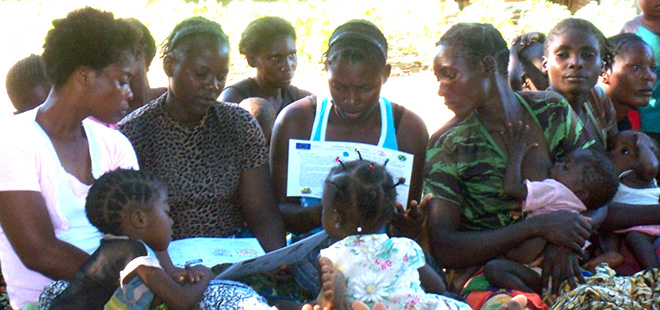
Producer group members using the Better Life Book to learn about the links between conservation, food security, and family planning. (Photo provided by COMACO program staff)
Family planning and reproductive health services have been prioritized in the USAID Multi-Sectoral Nutrition Strategy – as interventions that address the underlying and systemic causes of malnutrition. However, until recently, there was limited documentation on how to best integrate family planning programming with food security and nutrition programming. To address this gap, FANTA conducted an extensive desk review to identify and synthesize the experiences of USAID programs with this type of multisectoral programming. The results of the review have been incorporated into USAID guidance on the integration of nutrition, food security, and family planning programs, reaching a wide audience of public health and development practitioners. In addition, following the recommendations in the review, research is underway in Malawi to further explore how to systematically integrate family planning integration into development food assistance programs funded by the USAID Office of Food for Peace.
About the Review
Grey and published literature (such as program evaluation reports, annual reports, and implementation plans) from primarily USAID-funded programs was reviewed to identify those that integrated food security and/or nutrition interventions with family planning interventions between 2003–2013. There were 102 programs identified working in the areas of child survival; maternal, newborn, and child health; food assistance; population, health, and environment; and food security and agriculture.
The results of the review focus on how programs are integrating family planning with food security and nutrition. The review identified three models that programs used to integrate family planning services based on the type of family planning interventions offered through the program: 1) family planning education; 2) family planning education and counseling; and 3) family planning education, counseling, and commodities. All of the models included referrals to other family planning services. The review provides a range of program examples and case studies to illustrate how the models operate through various platforms (such as mobile clinics or farmer field days), providers (community and facility-level), and lifecycle contact points (such as antenatal and postnatal care).
The findings also revealed potential promising practices for integration. These practices include: building on existing platforms, targeting the 1,000-day window from a mother’s pregnancy up until the child is 2 years of age, conducting home visits, ensuring multiple contacts, and engaging men. To further strengthen integration, the review recommends that USAID:
- Define family planning and nutrition integration and family planning and food security integration, including success for this type of integration
- Harmonize reporting requirements
- Ensure adequate funding and time for implementation of integrated programs
- Fund rigorous research focused on testing effectiveness of integration models
- Develop guidance for and provide technical assistance to programs integrating family planning with nutrition or food security interventions
- Promote dialogue and cross-learning across health and multisectoral programs
“The FANTA 2015 Desk Review of Programs Integrating Family Planning with Food Security and Nutrition provides an excellent overview of the evidence available regarding the impact of integrated nutrition and family planning programs and the need to improve research to better document the impact of integration."
—USAID Technical Guidance Brief: Nutrition, Food Security, and Family Planning
Sharing Results
The review findings have captured interest from a wide range of audiences in various sectors of international development. Results have been shared through a USAID technical consultation, the USAID Mini University for global health professionals and students, presentations for maternal and child health working groups, and a webinar to share lessons from the population, health, and environment sector. In January 2016, findings were presented at the International Conference on Family Planning, and in May 2016, they were included in USAID technical guidance for its Multi-Sectoral Nutrition Strategy 2014–2025. The USAID Nutrition Food Security and Family Planning: Technical Guidance Brief offers key evidence on how voluntary family planning improves nutrition and food security and provides a summary of best practices and examples of integrated programming from the review.
Next Steps
Based on one of the review recommendations, formative research has been funded to look at how to integrate family planning in a USAID Food for Peace development food assistance project in Malawi. The activity is intended as a proof of concept to generate learning on a process to help identify how to best integrate family planning into Food for Peace projects, given overarching program design, local context, existing health system infrastructure, and beneficiary perspectives on family planning and service delivery. The process used for the assessment will be documented in a technical brief and the research tools will be made available so that they can be adapted by other nutrition and food security projects interested in pursuing family planning integration.


